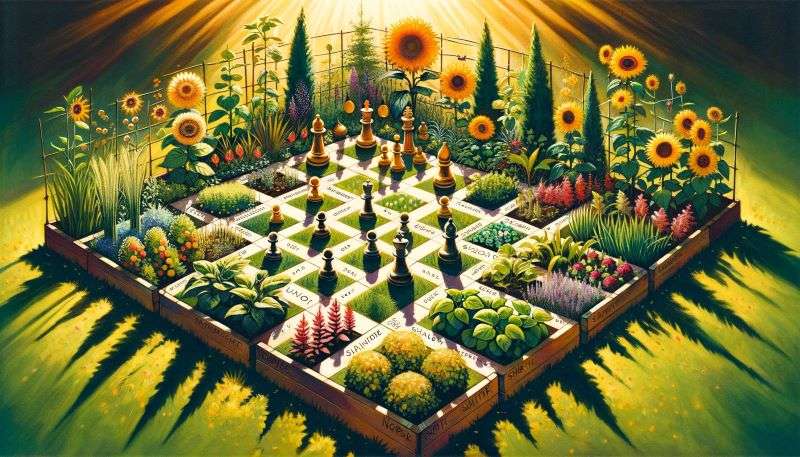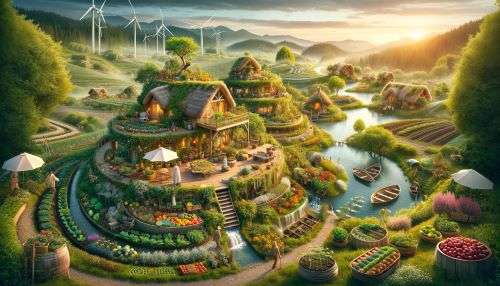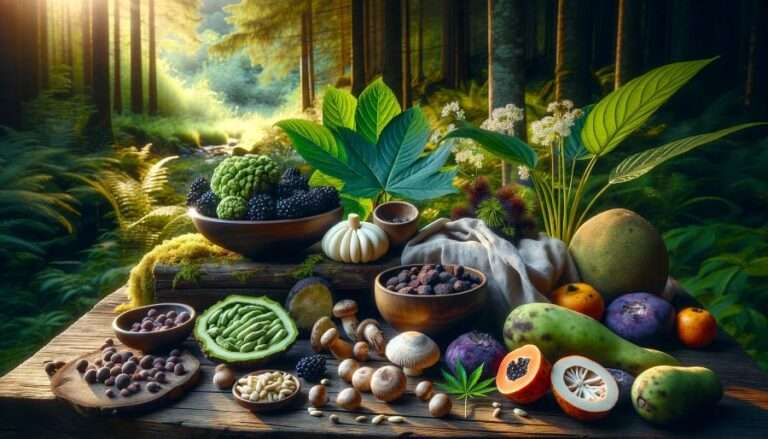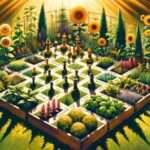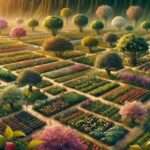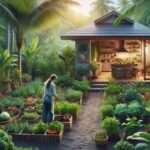This post contains affiliate links, through which we may earn a commission at no additional cost to you.
Table of Contents
Introduction
In living sustainably and peacefully cohabiting with our environment, few individuals are as influential as Bill Mollison, the permaculture pioneer. His doctrines, shaped with the expertise of a genius, form the foundation of restorative farming and ecological planning. We start on this immersive journey by examining my top seven permaculture principles from the wisdom of Mollison, each serving as a beacon lighting our path toward a more ecological future.
1. Stacking: The Layered Wonder of Nature
Picture a verdant forest where every crevice is an arena for life to effloresce. Stacking in permaculture ideology isn’t simply amassing stuff; it’s a discreet way to arrange elements that echo nature’s layered choreography. In the same way that taller trees provide shade and protection for smaller foliage in a forest, strategically placing varying crops can foster a thriving garden. Larger, solar-loving flora can assume the role of the lofty trees, shading and supporting the more minor, shadow-friendly plants underneath. This symbiotic arrangement isn’t just functional; it resonates like a beautiful poem.
2. Diversity: Nature’s Perfect Harmony
Diversity is instrumental in creating resilient ecosystems, a fact that Bill Mollison ardently advocates. Like robust ecosystems, our gardens are most productive when we celebrate diversity. A combination of various plants establishes a natural barrier against pests and diseases. Take the Three Sisters planting method, where corn, beans, and squash coexist symbiotically, each performing a specific function. Corn provides a natural support structure for the beans, while squash is a living weed suppressant, conserving soil moisture.
3. Bill Mollison’s Succession of Evolution: Strategies Perfected by Nature
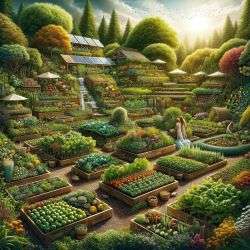
Mollison’s number three principle urges us to study the wisdom of nature and replicate its proven strategies. Consider it as being mentored by the ultimate teacher – Mother Earth. By embracing this principle, we use techniques that have endured over centuries. For example, the war on weeds can be won without chemicals, but instead with cover crops which naturally out-compete them, echoing the success of evolution in our own cultivated lands
4. Utilization of Onsite Resources: The Hidden Treasure of Your Landscape
Within permaculture, the fourth principle invites us to transform into resourceful stewards of our surroundings. Your garden should be able to self-sustain. Composting kitchen leftovers, recycling rainwater, and reincorporating organic matter into the soil are some ways we can tap into the wealth outside our front door. Picture converting kitchen waste into fertile compost, a return gift to earth that keeps offering.
5. Planting Plan: Nature’s Chess Game
Bill Mollison’s fifth principle is a strategic marvel where plants become chess pieces. By understanding the cycles of life and the depravations of different species, we can create a garden that capitalizes on synergy. Visualize planting tall solar-loving plants on the north side of shorter, shadow-friendly plants. It isn’t just a game of chess but a living, vibrant strategy where every move enhances the whole’s prospects of success.
6. Multiple Functions Supported by Every Element: The Marvel of Multitasking in Nature
The sixth rule invites us to marvel at the magic of multitasking in nature. Examples are trees that provide shade, create bird habitats, and yield fruits. In our permaculture quests, every component should have several purposes. Imagine a chicken coop that delivers fresh eggs, serves pest control, and fertilizes the ground. Each thing becomes a multitasking marvel, a crucial performer in the harmony of ecological living.
7. Relative Location: Striking a Balance Within Element Placement
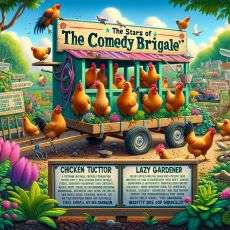
The seventh and last Bill Mollison’s principle, relative location, acts as a permaculture navigator guiding harmonious relationships among components. We optimize the whole system’s efficiency by strategically situating elements based on mutual benefits. Setting beehives near fruit trees in a permaculture orchard boosts pollination, promoting a mutually advantageous relationship that improves each component’s overall functionality.
For a deeper appreciation of permaculture and Bill Mollison’s principles, immersing yourself in permaculture farms to see these remarkable agricultural techniques firsthand is invaluable. Start your journey into the world of permaculture by exploring these farms:
5 Farms Practicing Permaculture Across the Globe: A World Symphony of Eco Sustainability
Beyond principles, tangible proof of the transformative power of permaculture exists—five farms, each a distinct narrative in the universal saga of sustainability.
Singita Sabi Sand, South Africa: An Ecological Safari
In South Africa’s heartland, Singita Sabi Sand is more than a tourist attraction; it is a sustainability sanctuary. Committed to permaculture, this reserve demonstrates the seamless incorporation of wildlife conservation into its principles, orchestrating a symphony where plants and wild animals coexist harmoniously.
Reaching Singita Sabi Sand in South Africa for an ecological safari adventure offers an unforgettable journey into the heart of the African wilderness, blending luxury, conservation, and unparalleled wildlife encounters. Here’s how to embark on this extraordinary experience, complete with transportation tips, accommodation options, activity suggestions, and essential packing advice.
Transportation to Singita Sabi Sand
By Air: The most direct route is to fly into Johannesburg’s O.R. Tambo International Airport. From there, take a connecting flight to an airstrip near Singita Sabi Sand, such as Skukuza or Kruger Mpumalanga International Airport. Private charters are also available for a more seamless journey directly into the reserve.
By Road: If you prefer the scenic route, renting a car from Johannesburg and driving to Singita Sabi Sand is a splendid adventure. The journey spans about 5 to 6 hours and provides a window into South Africa’s varied terrains.
Nearby Accommodations
Singita Sabi Sand offers opulent lodges that ensure a close bond with the natural world, all while providing unparalleled comfort:
- Singita Ebony Lodge is nestled among the trees on the banks of the Sand River. It offers private suites with plunge pools.
- Singita Boulders Lodge: A stunning lodge inspired by the boulders’ natural geometry, providing a unique blend of luxury and nature.
- Singita Castleton: Offering an exclusive, intimate retreat, Singita Castleton features a central main house offering shared living areas, complemented by six separate cottages scattered across the property. It’s perfect for families or groups seeking a private safari experience, complete with a personal staff team, chef, and guide.
- Lion Sands Ivory Lodge: Renowned for its breathtaking river views and exceptional service, Lion Sands Ivory Lodge provides ultra-luxurious villas with a private plunge pool and viewing deck. It’s an oasis of tranquility and luxury, ensuring a memorable stay amidst the wild.
- Ulusaba Rock Lodge: Perched high on a koppie, Ulusaba Rock Lodge offers spectacular views over the vast plains below. Every room and suite boasts its own unique decoration and style to reflect the beauty of its natural surroundings, offering guests a comfortable and stylish base from which to explore the African bush.
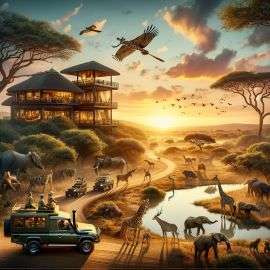
Activities in Singita Sabi Sand
Dive into a variety of thrilling experiences that allow you to experience the rich biodiversity and conservation efforts of the reserve:
- Guided Safari Walks: Explore the African bush on foot with experienced guides, learning about the flora, fauna, and ecosystems.
- Wildlife Drives: Venture in open safari vehicles for close encounters with the Big Five and other magnificent creatures.
- Community Visits: Understand the conservation efforts and community projects supported by Singita, fostering a deep appreciation of the area’s natural and cultural heritage.
- Stargazing: Discover constellations and celestial stories with expert guides under the African night sky.
What to Pack
Preparation is key to enjoying your safari in comfort and safety. Here’s what to bring along:
- Clothing: Pack light, breathable clothing for the daytime and warmer layers for cool mornings and evenings. Neutral colors are recommended to blend into the natural environment.
- Footwear: Durable, comfortable walking shoes for treks and safari walks.
- Sun Protection: A high SPF sunscreen, a wide-brimmed hat, and sunglasses to shield against the sun’s rays.
- Binoculars: Enhance your game-viewing experience
- Camera: Capture the breathtaking wildlife and landscapes.
- Insect Repellent: Protect yourself from mosquitoes, especially during dusk and dawn.
- A Good Book: FRelaxing in the serene ambiance of a Singita safari lodge, surrounded by the untamed beauty of Africa, calls for captivating reads that resonate with the spirit of adventure, the intricacy of nature, and the depth of human experience. Here are some book suggestions that are perfect companions for your moments of leisure:
- “Born a Crime: Stories from a South African Childhood” by Trevor Noah: In this riveting memoir, the comedian and “The Daily Show” host shares his journey growing up in South Africa, navigating the final years of apartheid and the chaotic era of liberation that ensued. It’s humorous and heartfelt and provides unique insights into South African life.
- “The Elephant Whisperer” by Lawrence Anthony with Graham Spence: This heartfelt and exhilarating true tale unfolds with a conservationist who welcomes a group of ‘rogue’ wild elephants into his Thula Thula game reserve in South Africa. It’s a testament to the bond between humans and animals and the complex social lives of elephants.
- “Out of Africa” by Isak Dinesen (Karen Blixen): A classic memoir that brings to life the author’s experiences running a coffee plantation in Kenya. It’s a love letter to the country’s landscapes and a reflection on her encounters with the people and wildlife that shaped her time there.
- “Dark Star Safari: Overland from Cairo to Cape Town” by Paul Theroux: For those who love travel narratives, this account of Theroux’s journey across Africa, from Cairo to Cape Town, is filled with vivid descriptions of the places and people he encounters, offering deep reflections on the continent’s complexities.
- “Cry, the Beloved Country” by Alan Paton: A deeply moving novel set in South Africa, this book explores themes of injustice, social disparity, and moral integrity through the story of a Zulu pastor and his son. It’s a profound reflection on the country’s physical and sociopolitical landscape.
- “Safari: A Memoir of a Worldwide Travel Pioneer” by Geoffrey Kent: This autobiography of the founder of luxury travel company Abercrombie & Kent offers an inside look at the creation of experiential travel and the adventures that inspired it. It’s a must-read for those interested in the evolution of safari and adventure travel.
Embracing these suggestions will ensure your visit to Singita Sabi Sand is luxurious, exciting, and deeply enriching. It will offer a unique perspective on conservation and the splendor of South Africa’s wilderness.
2. Zaytuna Farm, Australia: An Oasis of Permaculture Down Under
In Australia, Zaytuna Farm signifies the adaptability of permaculture principles. With an array of crops flourishing amid hand-sculpted swales, this gem from the Land Down Under vividly showcases the power of diversity.
Embarking on a journey to Zaytuna Farm, nestled in the lush hinterlands of New South Wales, Australia, promises an enlightening immersion into the world of permaculture. This oasis of sustainable living and learning, founded by permaculture co-originator Geoff Lawton, is a beacon for those seeking to understand and implement permaculture principles in their lives.
Reaching Zaytuna Farm
- By Air: The closest major airport to Zaytuna Farm is Gold Coast Airport (Coolangatta), approximately a 2-hour drive away. Alternatively, Brisbane Airport is another viable option, offering a slightly longer drive of about 2.5 hours to reach the farm.
- By Road: Renting a car from either airport provides the practicality and flexibility to explore the scenic beauty of the Northern Rivers region at your own pace. The drive to Zaytuna Farm is picturesque, winding through vibrant communities and stunning natural landscapes.
Nearby Accommodations
While Zaytuna Farm itself offers some accommodation options for students and visitors, several nearby lodges and B&Bs provide a cozy stay:
- The Earth House: A charming bed and breakfast that offers a serene retreat amidst nature, located in Corndale.
- Nimbin Rox YHA: A vibrant, budget-friendly hostel in Nimbin known for its colorful art and welcoming atmosphere.
- Black Sheep Farm: A boutique bed and breakfast in Bangalow offering rustic luxury with stunning countryside views.
- Suffolk Beachfront Holiday Park: Perfect for those who prefer to stay closer to the coast, offering cabins and camping options near Suffolk Park Beach.
- Byron Hinterland Villas: Luxurious villas in Clunes,offering a secluded getaway surrounded by sweeping views of the backcountry.
Activities at Zaytuna Farm
Participating in permaculture courses and workshops is at the heart of the Zaytuna Farm experience. Beyond structured learning, you can also:
- Join guided tours of the farm to see permaculture in action.
- Engage in hands-on activities like gardening or animal care, depending on the farm’s schedule.
- Explore the surrounding natural beauty through bushwalking and birdwatching.
- Enjoy quiet moments by the farm’s dams and natural water bodies.
What to Pack
For a comfortable and safe visit, consider bringing:
- Clothing: Lightweight, breathable clothes for the day and warmer layers for cooler evenings. Include a waterproof jacket for unpredictable weather.
- Footwear: Durable boots or shoes suitable for walking on uneven terrain and waterproof options for wet conditions.
- Protection: Pack a sun hat, apply sunscreen, and wear sunglasses to shield yourself from the sun’s rays; bring along insect repellent to keep the bugs at bay.
- Equipment: A reusable water bottle, binoculars for birdwatching, and a camera to capture the beauty of the farm.
- Great books:While relaxing at Zaytuna Farm, immerse yourself in literature that echoes the spirit of permaculture and sustainable living:
- “The One-Straw Revolution” by Masanobu Fukuoka: A seminal work on natural farming and the philosophy of working with, rather than against, nature.
- “Braiding Sweetgrass” by Robin Wall Kimmerer: An exploration of the intersection between traditional indigenous knowledge and modern science in understanding plants and ecosystems.
- “The Market Gardener” by Jean-Martin Fortier: Insights into small-scale organic farming for serious gardeners and aspiring farmers, focusing on efficient techniques.
Your journey to Zaytuna Farm is not just a visit to a place but a step into a lifestyle that honors the earth and fosters sustainability. With each day spent amidst its verdant landscapes, you’ll gather knowledge and inspiration to carry forward into your own life and community.
3. Finca Luna Nueva, Costa Rica: The Pure Life of Permaculture
Finca Luna Nueva is a permaculture paradise in Costa Rica’s green embrace. From the embrace of biodynamic farming methods to the incorporation of local plants, this farm encapsulates the principle of the success of evolution, reflecting the wisdom of nature in each leaf and blossom.
Embarking on a journey to Finca Luna Nueva in Costa Rica, where the ethos of “Pura Vida” (the pure life) meets permaculture principles, is an adventure into sustainable living and a deeper connection with nature. Here’s how to make your way to this ecological haven and what to expect upon arrival:
Getting There
By Air and Road: The most common route to Finca Luna Nueva begins with a flight to Juan Santamaría International Airport (SJO) in San José, Costa Rica’s capital. From San José, you have a couple of options:
- Rental Car: Opting for a car rental allows you to discover the sights at your leisure. The journey to Finca Luna Nueva is roughly a 3 to 4-hour drive, with the time-varying based on traffic flow and weather circumstances. Along the way, you’ll be treated to stunning views featuring mountains and lush rainforests, making the drive part of the adventure.
- Shuttle Service: Some travelers prefer a shuttle service, which can be arranged through the farm or local travel agencies. This option offers a hassle-free way to reach your destination and is ideal if you’re not keen on navigating Costa Rican roads.
Nearby Accommodations
While Finca Luna Nueva itself offers lodging, if you’re looking to explore nearby, here are five accommodations that harmonize with the natural beauty and ecological ethos of the region:
- Arenal Observatory Lodge & Spa: Offers breathtaking views of the Arenal Volcano, with a focus on eco-friendly practices and nature immersion.
- Chachagua Rainforest Eco Lodge: A paradise for nature lovers, focusing on sustainability and offering an authentic rainforest experience.
- Nayara Springs: Luxury villas for those seeking privacy and pampering amidst the lush Costa Rican rainforest, with a focus on sustainable luxury.
- Hotel Lomas del Volcán: Situated on a hillside with stunning volcano views, offering comfortable accommodations and easy access to outdoor adventures.
- El Silencio Lodge & Spa: A boutique eco-lodge known for its serene environment, organic cuisine, and commitment to sustainability.
Activities and What to Pack
On the Farm: Finca Luna Nueva offers various activities designed to connect you with nature and permaculture principles. Guided farm tours, chocolate-making workshops, bird watching, and yoga sessions are few ways to engage with your surroundings.
Packing Essentials: For a comfortable and safe experience, bring:
- Lightweight, Breathable Clothing: Ideal for the warm, humid climate. Long sleeves and pants can protect against sun and insects.
- Eco-Friendly Insect Repellent: Essential for evenings and nature walks.
- Sturdy Footwear: Waterproof hiking shoes for trails and flip-flops for leisure.
- Rain Gear: An easily packable, water-resistant jacket or poncho to ensure you stay dry during unexpected downpours.
- Sun Protection: Don’t forget to bring a pair of sunglasses, a broad-brimmed hat, and some high-SPF sunscreen.
- Binoculars and Camera: For bird watching and capturing the lush landscapes.
- Books to Read: While relaxing at Finca Luna Nueva, immerse yourself in literature that reflects the spirit of your surroundings:
- “The World Without Us” by Alan Weisman: Explores the impact of humanity on the environment and what the planet might look like if humans were no longer present.
- “The Overstory” by Richard Powers: A novel that intertwines the lives of its characters with the life of trees, revealing our interconnectedness with nature.
- “A Sand County Almanac” by Aldo Leopold: An enduring masterpiece in the realm of environmental literature, providing deep understanding into the natural world and our place within it.
- “The Hidden Life of Trees” by Peter Wohlleben: Reveals the complex social network and family-like structures of trees, changing the way we see forests.
Finca Luna Nueva is not just a destination; it’s an invitation to explore sustainable living, connect with the earth, and rediscover the essence of Pura Vida. Through thoughtful preparation and an open heart, your visit can become a transformative journey into the heart of permaculture and ecological awareness.
4. Bealtaine Cottage, Ireland: A tapestry of Permaculture in Celtic Land
The Bealtaine Cottage narrates a Celtic saga of permaculture magic on the Emerald Isle. Emphasizing stacking and strategic planting, this secluded retreat in Ireland transforms a modest piece of land into a rich oasis, proving that size doesn’t matter in sustainable practices.
Embarking on a journey to Bealtaine Cottage in Ireland offers a unique glimpse into the lush, verdant world of permaculture set against Celtic history and landscapes. This magical retreat, nestled in the heart of County Roscommon, is not just a destination but an experience rich in ecological harmony and the gentle wisdom of sustainable living.
Reaching Bealtaine Cottage:
- By Air: The nearest international gateway is Dublin Airport. From Dublin, you can either rent a car or use public transportation to reach Bealtaine Cottage. The drive from Dublin to Bealtaine Cottage offers scenic views and takes approximately 2 to 3 hours.
- By Rail: Ireland’s train network provides a comfortable journey with Irish Rail, offering routes from Dublin to nearby stations such as Roscommon or Carrick-on-Shannon. From there, a short taxi ride will get you to Bealtaine Cottage.
- By Bus: Bus Éireann operates routes that connect Dublin to the closer towns near Bealtaine Cottage. It’s a budget-friendly option, with the final leg of the journey possibly requiring a taxi.
Nearby Accommodations
For those looking to stay close to Bealtaine Cottage, the following accommodations offer comfort and Irish hospitality:
- Gleeson’s Townhouse and Restaurant: Located in Roscommon town, this charming townhouse is a cozy stay with delightful local cuisine.
- The Landmark Hotel: Situated in Carrick-on-Shannon, offering stunning views of the Shannon River and luxurious amenities.
- Abbey Hotel Roscommon: An historic property with modern comforts, set in a tranquil setting ideal for relaxation.
- Bush Hotel: This eco-friendly hotel in Carrick-on-Shannon blends heritage with contemporary sustainability practices.
- Douglas Hyde Restaurant: Part of the Kilronan Castle Estate, offering a luxurious stay with a focus on fine dining.
Activities at Bealtaine Cottage
Bealtaine Cottage is a testament to the beauty and practicality of permaculture. Activities and learning opportunities include:
- Permaculture Workshops: Learn the principles of permaculture that guide the cultivation of Bealtaine Cottage.
- Guided Tours: Explore the gardens and woodlands with a knowledgeable guide.
- Nature Walks: Immerse yourself in the tranquil beauty of the Irish countryside.
- Photography and Painting: The picturesque landscapes offer endless inspiration for artists.
- Meditation and Yoga: Find peace and balance in the serene surroundings of Bealtaine Cottage.
What to Pack
The Irish climate can be unpredictable, so it’s best to come prepared:
- Layered Clothing: Weather can change swiftly, so layers are your best bet.
- Rain Gear: A waterproof jacket and umbrella are essentials.
- Comfortable Footwear: For exploring the gardens and nearby countryside.
- Sun Protection: Sunglasses and sunscreen for sunny days.
- A Good Book: While unwinding at Bealtaine Cottage, delve into these carefully selected reads that echo the spirit of your surroundings:
- “The Secret Garden” by Frances Hodgson Burnett: A timeless novel about the healing power of nature and the rediscovery of beauty in a neglected garden.
- “Gaia’s Garden: A Guide to Home-Scale Permaculture” by Toby Hemenway: Offers insights into creating rich, sustainable ecosystems in your own backyard.
- “The Celtic Spirit: Daily Meditations for the Turning Year” by Caitlín Matthews: A spiritual journey through the Celtic year, celebrating its wisdom and rituals.
- “Wilding: The Return of Nature to a British Farm” by Isabella Tree: An inspiring account of rewilding a traditional farm in England, with parallels to permaculture principles.
- “The Heritage of Trees: History, Culture, and Symbolism” by Fred Hageneder: Explores the deep connections between humans and trees, weaving together folklore, history, and the role of trees in various cultures.
Your visit to Bealtaine Cottage promises a retreat and an enriching experience that blends the art of permaculture with Ireland’s timeless beauty. Whether seeking knowledge, tranquility or simply a connection to the earth, this journey offers a path to understanding and appreciating the natural world in profound ways.
5. La Ferme Biologique du Bec Hellouin, France: Artistry Meets Agriculture
Contributing to the panoply of permaculture, France presents La Ferme Biologique du Bec Hellouin. This farm exemplifies the principle of every element having multiple functions, with every corner playing a role in an agricultural symphony.
La Ferme Biologique du Bec Hellouin, located in the picturesque region of Normandy, France, is a celebrated destination where artistry and agriculture merge in beautiful harmony. Known for its pioneering approach to permaculture and ecological farming practices, it offers a unique opportunity to explore sustainable living near nature. Here’s how to get there and make the most of your visit:
Reaching La Ferme Biologique du Bec Hellouin
- By Air: The closest major international airport is Paris Charles de Gaulle (CDG). From there, you can rent a car or take a train to reach Normandy. The farm is about a 2-hour drive from the airport, providing a scenic route into the French countryside.
- By Train: The closest railway station is in Bernay, approximately 20 minutes by car from the farm. Regular trains from Paris Saint-Lazare station will take you to Bernay, where you can get a taxi or a car to reach the farm.
- By Car: Driving from Paris is a straightforward route that takes around 1.5 to 2 hours. Follow the A13 motorway towards Rouen, then continue on the A28 towards Le Mans, exiting towards Bernay and following the signs to Bec Hellouin.
Nearby Accommodations
The area around La Ferme Biologique du Bec Hellouin offers charming lodging options that complement the serene, rustic experience of the farm:
- Auberge de l’Abbaye: Nestled in the heart of Bec Hellouin, this cozy inn offers a warm welcome and a traditional Normandy experience.
- Le Logis de Brionne: A short drive from the farm, this hotel provides comfort and fine dining, showcasing the best of local cuisine.
- Les Roulottes de la Risle: For a unique stay, these comfortable caravans by the riverside in Calleville offer an enchanting escape into nature.
- Chambre d’Hôtes La Marnière: A charming bed and breakfast offering a peaceful retreat and a friendly atmosphere.
- Domaine de Saint Léger: A beautiful estate offering guest rooms in a renovated 18th-century setting, surrounded by lush landscapes.
Activities on the Farm
La Ferme Biologique du Bec Hellouin is not just a farm; it’s an experience. Visitors can partake in:
- Guided tours of the permaculture gardens.
- Workshops on sustainable farming and permaculture design.
- Seasonal farm-to-table dining experiences.
- Yoga and wellness sessions amidst the tranquil gardens.
- Artisanal craft and local food markets (depending on the season).
What to Pack
- Clothing: Comfortable, casual wear for outdoor activities and layers for cooler evenings. Waterproof boots or sturdy shoes for walking around the farm.
- Rain Gear: A waterproof jacket or poncho, as Normandy weather can be unpredictable.
- Sun Protection: Sunscreen, a hat, and sunglasses for sunny days.
- Gardening Gloves: If you plan to participate in hands-on workshops.
- A Reusable Water Bottle: Stay hydrated while exploring the farm.
- Books to Enjoy: Immerse yourself in these curated book selections while unwinding at La Ferme Biologique du Bec Hellouin:
- “The Hidden Life of Trees” by Peter Wohlleben: A fascinating exploration into the social network and family life of trees, revealing the complex and connected life of forests. Wohlleben combines scientific research with his deep love for woodlands, offering readers a new perspective on the natural world around us.
- “Animal, Vegetable, Miracle: A Year of Food Life” by Barbara Kingsolver: This memoir chronicles Kingsolver and her family’s year-long journey to eat only locally sourced food, delving into the challenges and rewards of homegrown and farm-to-table living. It’s a compelling narrative that questions industrial food systems and celebrates the simple joy of connecting with the food we eat.
- “The Omnivore’s Dilemma: A Natural History of Four Meals” by Michael Pollan: Pollan investigates the origins of the food on our plates, tracing the ecological and ethical implications of our eating habits. This book is a cornerstone for anyone interested in understanding the impact of agriculture on our environment and the importance of sustainable farming practices.
- “Miraculous Abundance: One Quarter Acre, Two French Farmers, and Enough Food to Feed the World” by Perrine and Charles Hervé-Gruyer: The story of how the authors transformed a small plot of land in France into a highly productive farm using permaculture principles. It’s an inspirational read that showcases the potential of small-scale farming to provide abundant, sustainable food.
- “Dirt: The Erosion of Civilizations” by David R. Montgomery: This book takes a deeper look into the role soil has played in the history of civilizations, from ancient societies to modern times. Montgomery makes a compelling case for the importance of sustainable soil management in the face of environmental challenges.
These books are more than just reading material; they’re gateways to understanding our relationship with the earth and the critical role of sustainable practices in our survival and well-being. Whether you’re nestled in the comfort of a lodge at La Ferme Biologique du Bec Hellouin or back at home, these reads will surely enrich your appreciation for the natural world and the innovative ways we can nurture it.
Conclusion
Bill Mollison’s permaculture doctrines transcend traditional gardening, offering a profound blueprint for a regenerative, sustainable future. By weaving principles such as stacking, diversity, the success of evolution, the use of on-site resources, strategic planting, elements multitasking, and relative location into our landscapes, we not only cultivate our gardens but also become stewards of a flourishing, interconnected ecosystem.
Visiting permaculture farms embodies this transformative experience, granting us firsthand insight into the tangible benefits of living in harmony with nature. In these living laboratories, we witness the resilience and abundance that permaculture principles foster. These farms serve as beacons, demonstrating how to repair our relationship with the earth, restore biodiversity, and build resilient communities.
In embracing these principles, akin to a harmonious orchestra, each of us plays a vital role in echoing the symmetry of nature. Let us adopt these guidelines and seek out and support permaculture farms. By doing so, we step into a circle of learning and contribution, fostering environments where nature and humanity can thrive. This journey towards ecological mindfulness and sustainability starts in our backyards but flourishes magnificently in the shared spaces of permaculture farms worldwide.
How do Bill Mollison’s permaculture principles address soil health?
They emphasize building and maintaining healthy soil through organic practices, composting, and mulching to support long-term fertility and biodiversity.
In what ways do permaculture principles by Bill Mollison contribute to water conservation?
These permaculture principles aim to optimize water usage and reduce waste by advocating for the collection and storage of rainwater, the creation of swales, and the use of drought-resistant plants
Can Bill Mollison’s permaculture principles be applied in urban settings?
Yes, they can be adapted for urban environments through practices like vertical gardening, rooftop gardens, and creating green spaces to promote city sustainability.

